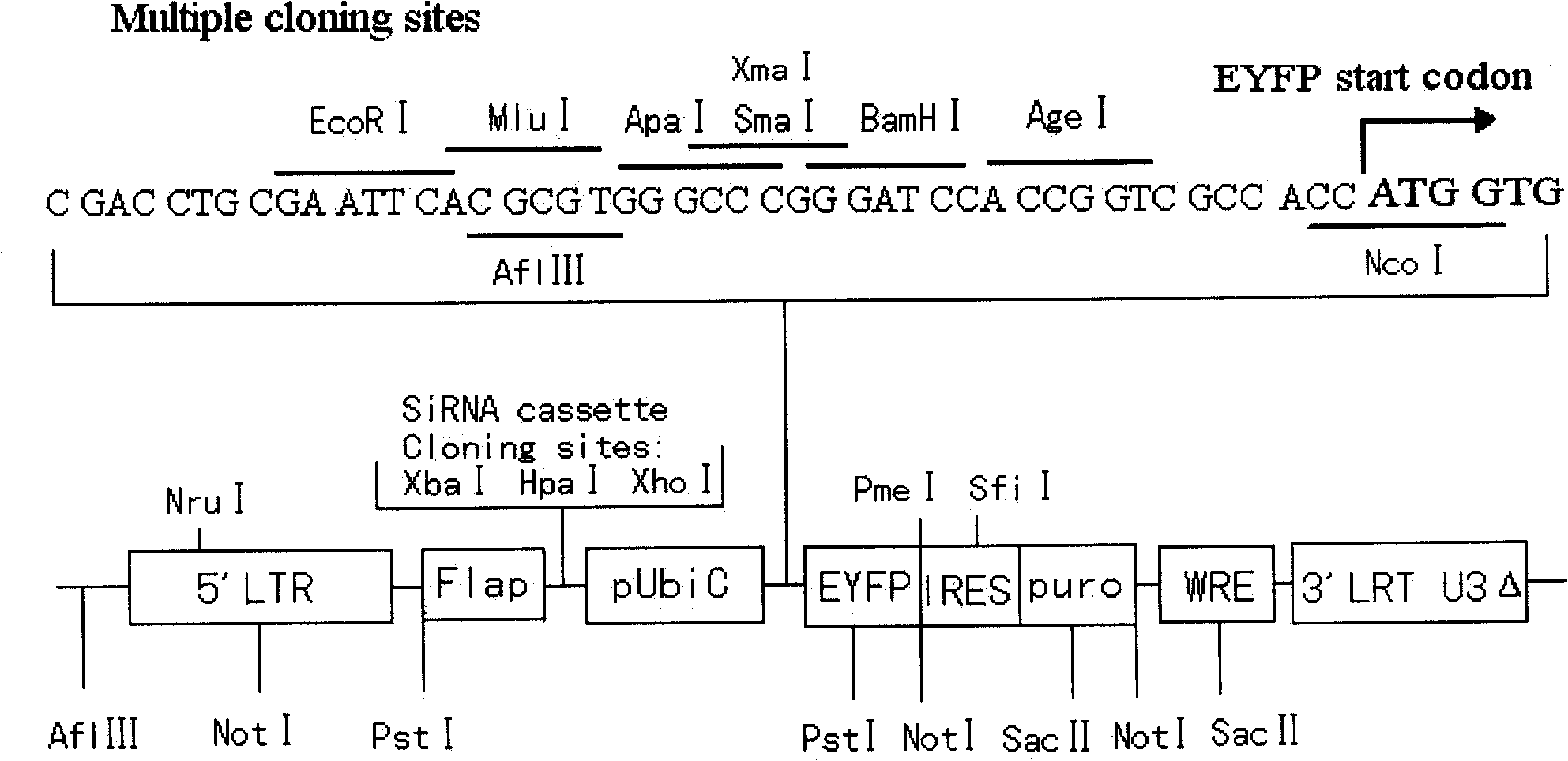SiRNA and recombination lentivirus from preventing hepcidin from regulating protein and uses thereof
A technology of recombinant lentivirus and regulatory protein, which is applied in the fields of molecular biology, biomedicine and genetic engineering to achieve the effect of inhibiting the expression of hepcidin-regulated protein in vivo, increasing the level of hepcidin, and treating diseases related to iron metabolism
- Summary
- Abstract
- Description
- Claims
- Application Information
AI Technical Summary
Problems solved by technology
Method used
Image
Examples
Embodiment 1
[0050] Based on the hepcidin regulatory protein (HJV) sequence (AK098165), and based on the human U6 sequence plus a 20bp U6 sequence linker and a PolyA termination message sequence. Add an XhoI restriction site to the 3' end, and send the synthetic sequence to Invitrogen Company. After screening, the HJV interference fragment sequence of the present invention with the most significant interference effect is obtained as follows:
[0051] Template strand (Seq ID No.3):
[0052] 5'-GTGGAAAGGACGAAACACCGTCAAAGGCTGCAGGAAGATTGTTGATATCCGCAATCTTCCTGCAGCCTTTGACTTTTTCTCGAGCTGGA-3'
[0053] Coding chain (Seq ID No.4):
[0054] 5'-TCCAGCTCGAGAAAAAGTCAAAGGCTGCAGGAAGATTGTTGATATCCGCAATCTTCCTGCAGCCTTTGACGGTGTTTCGTCCTTTCCAC-3'
Embodiment 2
[0056] PLT-HJVi system construction
[0057] Construction of recombinant PLT-HJVi plasmid as attached figure 2 , as shown in 3. The construction process is divided into three steps:
[0058] 1. Obtain the human U6 promoter;
[0059] a) Add 1ml SNET solution at room temperature to lyse 1X10 10 Human-derived cell line HEK293;
[0060] b) Draw the cell lysate from the mortar into a 2ml EP tube, add 40ul proteinase K and 2ul RNase;
[0061] c) Seal the EP tube, place the centrifuge tube horizontally in a 55-degree water bath, and slowly shake and digest for at least 3 hours;
[0062] d) Take out the EP tube, add 1ml of phenol-chloroform mixture, and gently invert 3 times. Shake slowly on a shaker for 30 minutes. (<60rpm);
[0063] e) Centrifuge for 5 minutes at the highest speed (13000rpm) of a desktop centrifuge at room temperature;
[0064] f) Carefully separate the aqueous phase into a new EP tube, add an equal volume of isopropanol, and gently invert to mix;
[0065...
Embodiment 3
[0121] Production process of recombinant lentivirus PLT-HJVi
[0122] 1. Inoculate 293T cells 1.5×10 7 cells in a 9cm culture dish (Corning), 37°C, 5% CO 2 Culture overnight;
[0123] 2. Change the fresh medium 20 minutes before transfection;
[0124] 3. Mix the PLT-HJVi plasmid with the lentiviral packaging plasmid P8.2 and P-VSV (both purchased from Invitrogen) according to the ratio of 9:8:1;
[0125] 4. Mix 20 ul of the above plasmid mixture with 500 ul of DMEM medium and mark it as tube A. Take another 20 ul of liposome and mix it with 500 ul of DMEM medium and mark it as tube B. Mix tube A and tube B, place at room temperature for 30 minutes, gently add the mixture to the culture medium of the 9cm petri dish in step 1, and incubate overnight;
[0126] 5. After 24 hours, add 7.5ml medium to continue culturing for 48 hours;
[0127] 6. Collect the cell supernatant and filter it with a 0.45um filter. The cells can be expanded and cultured, and the virus supernatant can...
PUM
 Login to View More
Login to View More Abstract
Description
Claims
Application Information
 Login to View More
Login to View More - R&D
- Intellectual Property
- Life Sciences
- Materials
- Tech Scout
- Unparalleled Data Quality
- Higher Quality Content
- 60% Fewer Hallucinations
Browse by: Latest US Patents, China's latest patents, Technical Efficacy Thesaurus, Application Domain, Technology Topic, Popular Technical Reports.
© 2025 PatSnap. All rights reserved.Legal|Privacy policy|Modern Slavery Act Transparency Statement|Sitemap|About US| Contact US: help@patsnap.com



